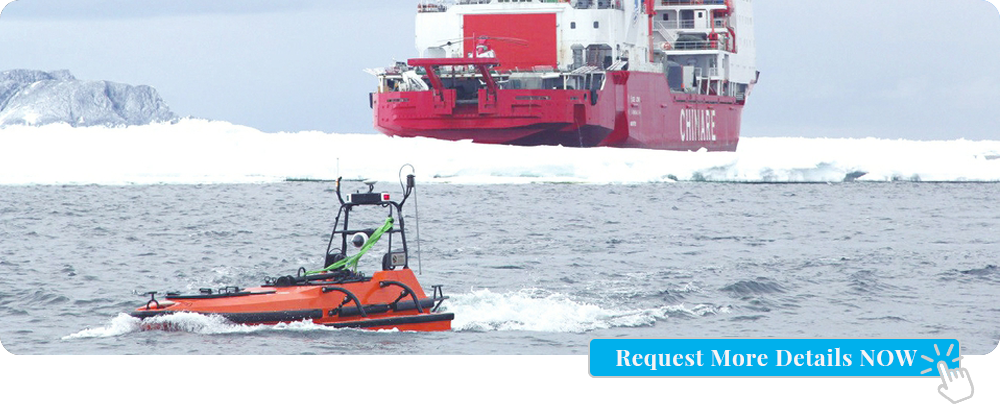Time: November 2017
Location: Antarctic Ross Sea Inexpressible Island and the waters near the Great Wall Station
Background: In November 2017, China’s 34th Antarctic scientific research was officially launched. The State Oceanic Administration used 4 USVs in the Antarctic to perform the task of finding a new anchorage for the polar scientific research ship “Xuelong”.
01 Challenge:
【Challenge ①】The polar working conditions are complex and the natural conditions are harsh. The number of satellites in high-latitude areas is limited, and the positioning accuracy decreases.
【Challenge ②】 Lack of complete local geographic data.
【Challenge ③】 Low-temperature icing will affect the stability of the ship and increase the error of survey data.
【Challenge ④】 The repeated impact of ice floes and sea waves requires speed, seakeeping, and corrosion resistance of the vessel.
【Challenge ⑤】 The repeated impact of ice floes and sea waves requires high speed, seakeeping and corrosion resistance of the vessel.
【Challenge ⑥】 Scientific survey vessels have high costs in fuel and labor.
Based on the above difficulties, State Oceanic Administration customize the “polar version” unmanned vessel platform to implement the seabed detection mission and complete the anchorage water depth and terrain survey of China’s fifth Antarctic research station.
02 Solution:
In this survey mission, 4 USVs were used including 1 unit of 5.65m M80 USV and 3 units of 1.65m SE40 small USV.
 |
 |
| M80 Marine Survey USV | SE40 small USV |
M80 USV installed a multi-beam echo sounder for deep water seabed survey.
 |
 |
Figure | M80B bow GNSS antenna installation position of the choke structure
In order to better break the ice, M80 marine survey USV adopts a trimaran hull design, which performs well in terms of speed, stability, and seakeeping. The hull is forged with high weather resistance aluminum alloy with good strength and corrosion resistance. Considering the high salinity of seawater, the USV also uses corrosion-resistant materials.
In order to improve the positioning accuracy, the POS (Position & Orientation System) solution uses the dual-satellite positioning antenna, and the inertial measurement unit (IMU) is tightly coupled with the POS to provide high-precision positioning and heading data.
In order to improve the signal-to-noise ratio of positioning data, a choking structure mounting surface that can weaken the multi-path effect on the water surface is designed at the relatively low bow antenna installation position to improve the quality of satellite positioning data.
M80 USV deployed in Xuelong mother vessel
SE40 small USV is integrated with a single beam echo sounder for the bathymetric survey of the coastal area near the Great Wall Station.
After about 20 hours of work, the USVs completed the multi-beam full-coverage survey in the 5㎞² sea area in the surrounding waters of Inexpressible Island. It provides basic spatial geographic information data support for the safe navigation of ships and the construction of China’s fifth Antarctic scientific research station.
03 Advantage Analysis:
The application of the USV survey has made some path-finding tasks ahead of the Antarctic scientific research more real-time, safe, efficient, accurate and economical.
01 Real – time
Compared with manned vessels, USV can navigate and monitor the survey site and return high-definition video images in real-time to support the survey work.
Monitoring the survey site
02 Safety
The unmanned vessel has the ability to work in harsh natural environments. In addition to the severe cold, this Antarctic project operation also encountered conditions such as ice floes and strong winds. The USV has overcome the above difficulties and completed scheduled tasks within the specified time, which reduced the labor intensity and ensured the safety of personnel.
Part of the water depth topographic map
(Extracted from the public information of the 2018 annual meeting of the Oceanographic Surveying and Mapping
Professional Committee of the Chinese Ocean Society)
03 Efficiency
The USVs were launched into the water from the mother vessel, and the mission line was pre-set and sent to the USV to start the survey operation. It took about 20 hours for the USV to automatically complete the multi-beam full-coverage seabed survey of a 5 square kilometer sea area. In the future, multi-vessel cooperative surveys can be used to enhance more in efficiency.
M80 USV multibeam survey of terrain of Inexpressible Island
(Obvious traces of glacial erosion can be seen on the seabed)
04 Accuracy
The “wave-piercing” bulbous bow applied on the M80 USV platform reduces the pitch and decreases the interference to the acoustic equipment to guarantee the quality of survey data. The USV can also be equipped with an auto lifter and a fully watertight equipment cabin to protect the survey equipment.
05 Economical
The USV energy consumption is only one-tenth of that of manned ships, which saves a lot of fuel costs for the mother ship operating in the ocean, meanwhile, the payload capacity can be given up for other materials.
04 Conclusion:
The application of USV in the participation of the Antarctic research has fully demonstrated the advantages of safety, efficiency, and economy.
Scientific expedition personnel only need to command the USV to conduct ocean survey and obtain high-quality data. It can also enter into challenging waters, further expanding the scope of operations.
— Other OceanAlpha USV Recommendations —






